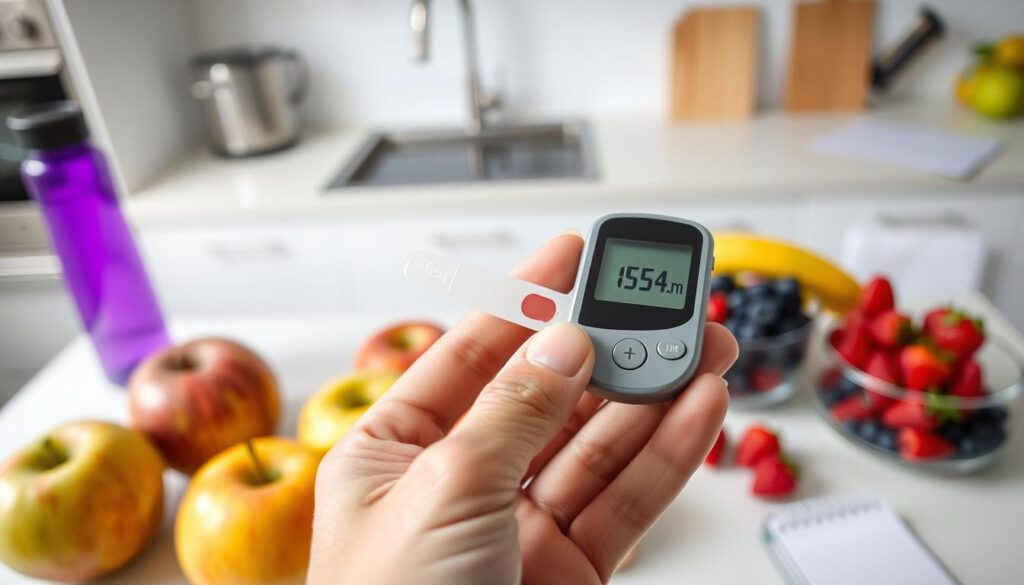Did you know a single tablespoon of sugar can raise blood sugar levels a lot? This fact shows how vital it is to manage blood sugar for good health. Having dealt with prediabetes myself, I know how hard it can be. But, I’ve found useful ways to keep glucose levels healthy.
In this guide, I’ll share my knowledge and tips to help you control your blood sugar. We’ll cover everything from glucose and insulin to monitoring and healthy eating. This will give you the tools to manage your blood sugar well.
Key Takeaways
- Carbohydrates have the biggest impact on blood sugar levels, so it’s crucial to monitor and control your carb intake.
- Maintaining a healthy weight, eating a balanced diet, and getting regular physical activity can help manage blood sugar levels.
- Proper storage and use of insulin are essential for effective diabetes management.
- Adjusting insulin doses before exercise and having a plan for managing diabetes during illness are important considerations.
- Monitoring blood sugar levels and identifying trends can provide valuable insights to help you make informed decisions about your health.
Understanding Blood Sugar Levels
Glucose and Insulin
Keeping blood sugar levels healthy is key for our well-being. Glucose is our main energy source, coming from carbs and sugars in our food. Insulin, made by the pancreas, helps our cells use glucose from the blood.
In type 2 diabetes, the body can’t use insulin well. This makes blood sugar levels go up. Knowing how glucose and insulin work together is important for managing blood sugar and preventing or managing type 2 diabetes.
| Blood Glucose Target Range | Frequency of A1C Tests |
|---|---|
|
At least twice a year for individuals with diabetes |
Using tools like blood glucose meters and CGM systems helps track how well the body manages glucose. Regular testing and tracking patterns can help those with diabetes make better care choices.
Understanding glucose and insulin is vital for managing blood sugar and preventing or managing type 2 diabetes. By staying informed and working with healthcare providers, individuals can take steps to keep blood sugar levels healthy and improve their well-being.
Monitoring Blood Sugar
Keeping an eye on your blood sugar is key to managing diabetes well. I’ve learned that checking your blood sugar often is vital. It helps keep your levels healthy and prevents problems.
Doctors can help set the right blood sugar targets and how often to test. Tests like fasting blood glucose and HbA1c show how well you’re managing diabetes. People with diabetes often use a glucose meter to check their blood sugar levels many times a day.
The American Diabetes Association suggests keeping blood sugar between 80 to 130 mg/dL before meals. After meals, it should be under 180 mg/dL, especially 1 to 2 hours later. It’s also important to get A1C tests twice a year, along with regular blood sugar monitoring at home.
Tracking and recording your blood sugar results is crucial. It helps spot patterns and make needed changes. Sadly, over one-third of Americans with diabetes don’t manage their condition well. Those who do check their blood sugar regularly make better choices about food, exercise, and insulin.
| Metric | Recommended Range |
|---|---|
| Fasting Blood Glucose | 80 to 130 mg/dL |
| Blood Glucose After Meals | Less than 180 mg/dL |
| HbA1c | At least twice a year |
Continuous glucose monitors (CGMs) offer 24-hour blood sugar monitoring. They give a better view of blood sugar changes than traditional meters and finger tests. CGMs can send alerts for low or high glucose, helping manage blood sugar levels better.

It’s important to keep your blood sugar monitoring gear in good shape. Don’t share lancets and keep test strips dry and away from extreme temperatures. Warming up your hands before testing can also help.
Regular blood sugar monitoring and active management are essential for a healthy life with diabetes. By following these tips and working with your healthcare team, you can manage your blood sugar levels well.
Blood Sugar Levels and Diagnosis
Keeping your blood sugar levels healthy is key to feeling good. Knowing the different levels and what they mean can help you manage your health better. Normal blood sugar is under 100 mg/dL. Levels between 100-125 mg/dL mean you might have prediabetes. And, if your blood sugar is 126 mg/dL or higher, you could have type 2 diabetes.
The American Diabetes Association (ADA) says people with a BMI over 25 (23 for Asian Americans) and other risk factors should get tested for diabetes. Diabetes is diagnosed when your A1C level, which shows your blood sugar over 2-3 months, is 6.5% or higher on two tests.
Prediabetes is when your A1C level is between 5.7% and 6.4%. This is a chance to change your lifestyle and stop type 2 diabetes from happening. Studies show that people with prediabetes can cut their risk of getting type 2 diabetes by 58%. They can do this by losing 7% of their body weight and exercising regularly.
| Measurement | Normal Range | Prediabetes Range | Diabetes Range |
|---|---|---|---|
| Fasting Plasma Glucose (FPG) | Less than 100 mg/dL | 100-125 mg/dL | 126 mg/dL or higher |
| A1C | Less than 5.7% | 5.7%-6.4% | 6.5% or higher |
| Oral Glucose Tolerance Test (OGTT) | Less than 140 mg/dL | 140-199 mg/dL | 200 mg/dL or higher |
| Random (Casual) Plasma Glucose | Less than 200 mg/dL | N/A | 200 mg/dL or higher |
Spotting and managing blood sugar levels early is vital for your health. It helps avoid serious problems linked to prediabetes and type 2 diabetes.
Healthy Eating Habits
Keeping a healthy diet is key for managing blood sugar. Eating a balanced diet helps control carbs and portion sizes. Focus on whole carbs like fruits, veggies, and whole grains. Avoid refined carbs and added sugars for better health and blood sugar control.
Meal Planning Strategies
Using meal planning strategies like the plate method or carb counting is helpful. The plate method fills half your plate with veggies, a quarter with protein, and a quarter with carbs. Carb counting tracks carb intake to stay within daily limits. Both methods help make smart food choices and improve blood sugar control.
Eating a variety of nutrient-rich foods is important. Include lean proteins, healthy fats, and high-fiber carbs. Eating heart-healthy fish like salmon twice a week is good for omega-3s. Plant-based proteins like legumes, nuts, and seeds also add variety and support health.
Healthy eating and meal planning help manage blood sugar and prevent complications. A balanced diet nourishes your body and mind for a better future. It’s not just about carbs; it’s about overall health.

“Proper nutrition is the foundation for a healthy lifestyle, especially when managing a condition like diabetes. With thoughtful meal planning and a focus on whole, nutrient-rich foods, you can take control of your blood sugar and thrive.”
The Importance of Exercise
Regular physical activity is key for managing blood sugar levels. It helps muscles use glucose, lowering blood sugar. It also makes the body use insulin better. But, people with diabetes need to watch out for low blood sugar after exercise and get help from their healthcare team.
Exercise can lower blood sugar for up to 24 hours after. It also improves blood sugar control over time. Yet, those taking insulin or certain medications might get low blood sugar if they don’t adjust their doses or food intake.
To avoid low blood sugar during and after exercise, follow the 15-15 rule. Eat 15-20 grams of carbs to raise blood sugar. Doctors might suggest a small snack before exercise or adjust medications to prevent low blood sugar.
- Adults should aim for at least 150 minutes per week of heart-pumping aerobic activity.
- Adults should also engage in 2 to 3 strength-training sessions per week.
- Children and teens with diabetes should get at least 60 minutes of moderate to vigorous aerobic activity daily.
Regular physical activity helps manage blood sugar, improves insulin use, and lowers risk of complications for those with diabetes. It’s important to work with healthcare professionals to create a safe and tailored exercise plan.
| Metric | Value |
|---|---|
| Percentage of Americans diagnosed with diabetes categorized as physically inactive | 34.3% |
| Percentage of Americans diagnosed with diabetes meeting the 150-minute segment of physical activity guidelines per week | 23.8% |
| Decrease in cardiovascular mortality associated with engaging in physical activity as per guidelines | 40% |
| Decreased incidence of diabetes for men with cardiorespiratory fitness (CRF) levels greater than 31.0 mL of oxygen per kilogram per minute who exercised at moderate intensity for over 40 minutes per week | 64% |
| Average risk reduction of type 2 diabetes when comparing the most active to the least active participants in cohort studies | 42% |
| Reduced risk of developing type 2 diabetes for women who reported at least weekly vigorous exercise | 16% |
| Lower risk of incident diabetes for individuals who achieved at least 12 metabolic equivalents (METs) | 54% |
“Engaging in physical activity as per guidelines has been associated with a 40% decrease in cardiovascular mortality.”
By making physical activity a regular part of their lifestyle, individuals with diabetes can effectively manage their blood sugar levels, improve insulin sensitivity, and reduce the risk of complications. However, it’s crucial to work closely with healthcare professionals to develop a safe and personalized exercise plan.
Medication Management
Managing diabetes medications is key for those with the condition. It’s important to know how to store and use insulin. Also, understanding how other medications can affect blood sugar is crucial.
Timing medications with meals and exercise helps keep blood sugar stable. This is important for a healthy day.
Insulin and Other Diabetes Medications
Insulin is vital for many with diabetes. It helps control blood sugar. Insulin should be stored in the fridge and used correctly, either through injections or an insulin pump.
Oral diabetes medications like metformin, DPP-4 inhibitors, and SGLT2 inhibitors are also used. They can be taken alone or with insulin. Each has its own role in managing blood sugar.
When to take medications matters. For instance, metformin is taken twice a day and can cause diarrhea. Some meds, like DPP-4 inhibitors, don’t cause weight gain. Others, like sulfonylureas, can lead to weight gain and low blood sugar.
It’s important to work with your healthcare team. Doctors and pharmacists help manage medications. Regular checks ensure you’re meeting blood sugar goals and avoiding side effects.
“Only about 50% of people with diabetes reach their blood glucose goals as measured by hemoglobin A1C testing.”
By following your healthcare provider’s advice and medication instructions, you can manage your diabetes better. This improves your health and well-being.
Dealing with Illness
Living with diabetes, I’ve learned how sickness affects blood sugar. When we’re sick, stress hormones can raise blood sugar levels. Changes in how much we eat and move can also impact our glucose levels. It’s vital to have a plan for managing diabetes when we’re not feeling well.
Watching for ketones is important. When we can’t use glucose, our bodies break down fat, leading to ketones. This is especially risky for those with type 1 diabetes. I regularly test for ketones, especially when my blood sugar is high.
Adjusting my medication is key when I’m sick. I work with my healthcare team to adjust my insulin doses. Drinking plenty of water is also crucial, as dehydration can worsen high blood sugar.
| Illness Symptoms | Potential Blood Sugar Impact | Management Strategies |
|---|---|---|
| Fever, Infection, Stress | Increased Blood Sugar Levels |
|
| Nausea, Vomiting, Decreased Appetite | Decreased Blood Sugar Levels |
|
When I’m sick, talking to my healthcare team is crucial. They help me manage blood sugar, medications, and other health issues. With the right plan and support, I can manage my diabetes even when I’m not feeling well.
Conclusion
Managing my blood sugar levels is key to staying healthy. I understand how glucose and insulin work. Regular checks and healthy habits help me keep my levels right.
Exercise, managing meds, and being ready for sickness are also important. These steps help me control my blood sugar and improve my life. They also prevent diabetes complications.
Keeping my blood sugar in check is a big deal for me. I watch my levels, eat right, and stay active. This way, I avoid serious health problems.
By focusing on my health, I live better and feel more in control. It’s all about making smart choices for my well-being.
Managing blood sugar is a journey, but it’s worth it. With the right approach, I protect my health and prevent diabetes. This way, I live a happier, more energetic life.
By prioritizing blood sugar management, I invest in my future. I’m setting myself up for a healthier, happier life ahead.










